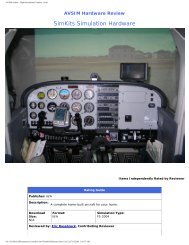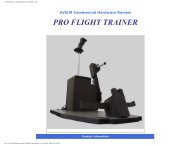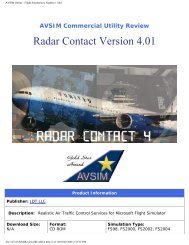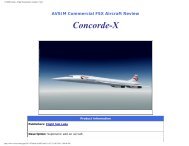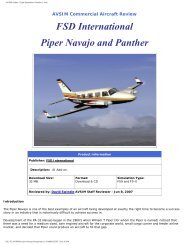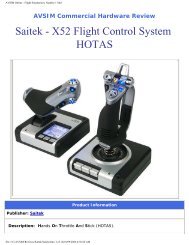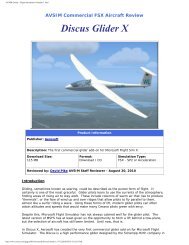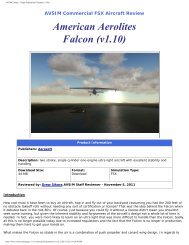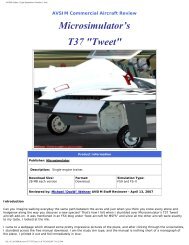Republic P-47 Thunderbolt - AVSIM Online
Republic P-47 Thunderbolt - AVSIM Online
Republic P-47 Thunderbolt - AVSIM Online
You also want an ePaper? Increase the reach of your titles
YUMPU automatically turns print PDFs into web optimized ePapers that Google loves.
<strong>AVSIM</strong> <strong>Online</strong> - Flight Simulation's Number 1 Site!<br />
Flight Model<br />
“P-<strong>47</strong>M 2D panel with windows open” “P-<strong>47</strong>M 2D panel no windows”<br />
The P-<strong>47</strong> is a very heavy aircraft. So to counter this, a very powerful engine is needed, which is also very heavy,<br />
making this aircraft nose heavy on landings. We cannot forget this characteristic of the P<strong>47</strong>. The WOP team did a<br />
good job with the P-<strong>47</strong>’s flight model. The aircraft performs right down to the numbers as the real P<strong>47</strong>’s did. In a<br />
dive, this aircraft is unbeatable in speed and stability, but in a climb, it was sluggish, and contributed to one of it<br />
nick-names, the Jug.<br />
Takeoff is tricky, as you will find in a 2500HP tail-dragger. Make sure you are lined up before you unleash the power<br />
of this aircraft, because it’s difficult to use rudder once the tail wheel is off the ground. Also, WOP makes their<br />
aircraft perform just like they do in real flight, so read the manual to achieve the correct takeoff power setting, as<br />
you don’t always want to use max power on takeoff. (Takeoff power is a little bit less than max performing power.)<br />
Test System<br />
Win XP Professional<br />
2.6GHZ P4<br />
85GB HDD<br />
1GB RAM<br />
ATI Radeon X850 Pro 256MB<br />
Saitek X52 Joystick Digital<br />
Programming Console MFD<br />
CH Pro Pedals<br />
Audigy 2 Soundcard<br />
Flying Time:<br />
17+ hours<br />
After getting airborne, the aircraft will perform nicely at all altitudes, because of the<br />
altitude staged supercharger and WEP (War emergency power). I found that without<br />
enough speed in a tight turn, the aircraft will stall and sink hard, and it can be<br />
difficult to recover. Make sure when performing loops or tight turn, not to “jam” the<br />
stick and rudder around, or the aircraft will stall, clean or loaded. When performing<br />
acrobatics, make sure you are at a safe altitude so you can dive the aircraft, (what<br />
this plane does best) and perform your turns with enough speed. I use about 70%<br />
back pressure on my joystick to keep it from stalling, but still keeping a nice turn.<br />
The aircraft will bleed your airspeed off fast when you pitch up with no power, just<br />
like the real one did. (It’s heavy!)<br />
Ok, so you’re flying about your local airport, and start to become bored of flying in<br />
circles. That’s ok! The P<strong>47</strong> has an astounding range, if power is trimmed correctly.<br />
You can fly the P<strong>47</strong> a long way. Its range is over 1500 miles and an altitude ceiling<br />
of over 39,000 feet. So go ahead, it’s cross country time!<br />
Landing is the most difficult part of flying the P<strong>47</strong>. If you’re full of gas, you’re not<br />
going to have a fun time getting the P<strong>47</strong> on the deck. The engine weights so much,<br />
you need more of a speedy approach to be successful. Don’t find yourself short of<br />
the runway because powering up and climbing out isn’t a snap like the P51. I almost always bring my fuel way down<br />
to about 30% when I’m just flying about, so I can make an easier landing. Even with the fuel low, landing is still<br />
difficult because the nose is long and you can’t see over it very well. Make sure your seat is boosted up in the Virtual<br />
Cockpit, and don’t slip down into the landing configuration until your sure you can make the landing. Once you touch<br />
down, I bring up my flaps to prevent the aircraft from jumping up again. And don’t worry; the brakes won’t flip the<br />
plane over unless you use the parking brakes!<br />
Taxiing is done by “swerving” the plane side to side so the pilot can see out the left/right window. If you aren’t really<br />
a good “taxier” I suggest you use spot view. Use differential brakes to get around tighter turns, but otherwise the<br />
aircraft taxi's well. Make sure not to idle too low or the engine will cut after several seconds!<br />
After finishing my final series of flights, I concluded that the P<strong>47</strong> will indeed perform like the real aircraft did. The<br />
Wings of Power team has always impressed me with the accuracy of their other product's flight model. The WOP<br />
file:///C|/<strong>AVSIM</strong>/Reviews/WOP-P<strong>47</strong>/P<strong>47</strong>.htm (4 of 6)31/05/2006 11:18:38 AM



